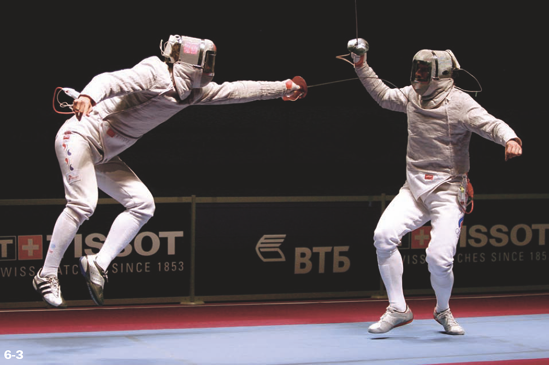6.2. FAST VERSUS SLOW LENSES
A fast lens is a lens that provides a large aperture — meaning less than f/3.0. Why is it called fast, then? It is because a larger aperture provides more light for the digital sensor, meaning you can use a faster shutter speed in your images where there's less light, as in 6-3. Consequently you can shoot faster, not that the lens itself does anything more quickly. It also means you can achieve better narrow depth-of-field images because you have a wide aperture.
Fast lenses, especially zooms, are generally more expensive and are of higher optical quality. Lower-quality, slower zoom lenses commonly have a wider, variable aperture that narrows as the focal length increases. For example, Canon's EF 70-300mm lens ranges from f/4 to f/5.6 depending upon your focal length; at 300mm, the lens physically does not offer an aperture of f/4, and you won't be able to even manually select that f-stop on the camera.
Figure 6-3. A stop-action image of men's sabre fencing taken at the 2007 World Fencing Championships in St. Petersburg, Russia. A fast lens is a critical tool for taking this type of photograph. Taken with a 1D Mark IIn, EF 70-200mm f/2.8L lens, ISO 800, 1/1000 second at f/2.8. ©Serge Timacheff

Variable apertures with settings dependent on focal length are often confusing. If you set a variable aperture lens, such as 70-300mm, at 70mm and set your ...
Get Canon® EOS Digital Photography Photo Workshop now with the O’Reilly learning platform.
O’Reilly members experience books, live events, courses curated by job role, and more from O’Reilly and nearly 200 top publishers.

